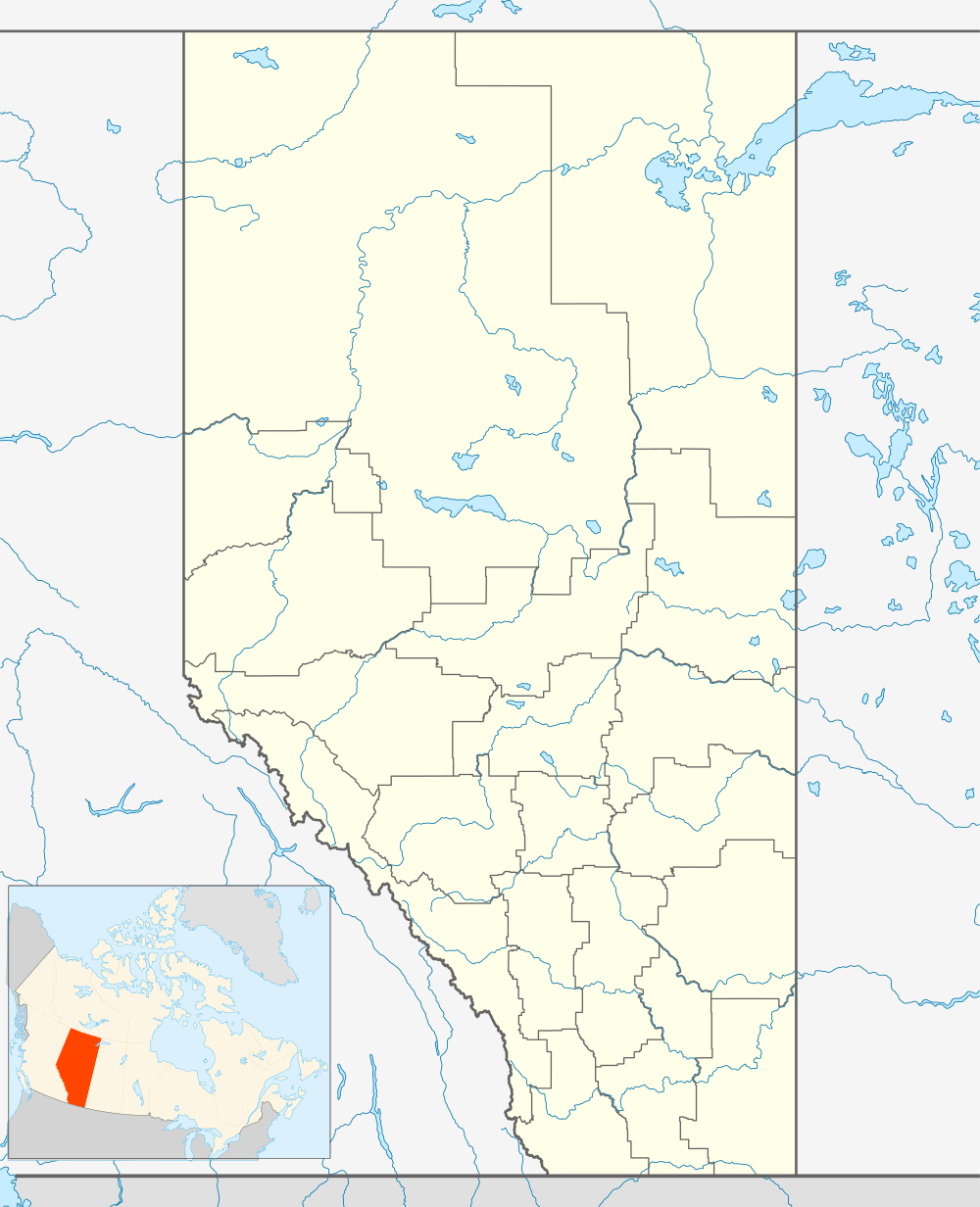Irvine, Alberta
| Irvine | |
|---|---|
| Hamlet | |
 Location of Irvine in Alberta | |
| Coordinates: 49°57′19″N 110°16′36″W / 49.9553°N 110.2767°WCoordinates: 49°57′19″N 110°16′36″W / 49.9553°N 110.2767°W | |
| Country |
|
| Province |
|
| Census division | No. 1 |
| Municipal district | Cypress County |
| Government | |
| • Type | Unincorporated |
| • Governing body | Cypress County Council |
| Elevation[1] | 763 m (2,503 ft) |
| Population (2011)[2] | |
| • Total | 291 |
| Time zone | MST (UTC-7) |
| Area code(s) | 403 |
Irvine is a hamlet in Alberta, Canada within Cypress County.[3] It is located approximately 35 kilometres (22 mi) east of Medicine Hat on Highway 1 and has an elevation of 763 metres (2,503 ft). The hamlet is located in census division No. 1 and in the federal riding of Medicine Hat.
History
The vast prairies were home to the Cree and other indigenous groups who traversed the area in and around the nearby Cypress Hills, following the routes of the bison. By 1870, the bison were all but gone. The Palliser Expedition passed through the region in 1859. Métis settled in the hills during the mid-1860s, and the Cypress Hills Massacre occurred in 1873.
A settlement developed around a trading post, and became known as 20 Mile Post - 20 miles from the next trading post at Medicine Hat. It later was renamed Irvine in honour of Colonel A. Irvine, a commissioner of the North-West Mounted Police who served with General F.D. Middleton during the North-West Rebellion of 1885.
In early May 1883, the push was on to complete the Canadian Pacific Railway line from just east of Walsh to Medicine Hat. Crews of gandy dancers worked hard, building the rail line through 20 Mile Post, and reaching Medicine Hat on May 31.[4] Trains brought Europeans with high hopes for their futures to the area. Today, lengthy freight trains roll through Irvine in the blink of an eye.
Many German-Russian settlers homesteaded in the area and some of their descendants remain in and around Irvine to this day. The century-old St. George's Parish Cemetery bares evidence of this history.[5]
Prior to September 1, 1905, the community was within the jurisdiction of the Assiniboia District of the Northwest Territories. It then became part of the Province of Alberta.
Irvine was once a thriving community, complete with an elected mayor and town council, several churches, businesses, etc. Several grain elevators once thrust their lofty towers to the sky. Blacksmith shops were kept busy making and repairing equipment for local ranchers and farmers. Agriculture is the mainstay of the district's economy. Over the decades, however, the demographic changed and the town dissolved into a hamlet within Cypress County. The old town office building is on the main street.
Geography
An unusual geological formation was discovered northeast of Irvine when Google Earth images showed what has become known as the Badlands Guardian, a shape in the land that looks like a North American Indian[6] wearing a feathered warbonnet.
Demographics
Cypress County indicates that the population of the Hamlet of Irvine was 291 in the 2011 Census.[2]

Arts and culture
During the September long weekend, Irvine is home to the 20 Mile Post Days. This annual event includes a pancake breakfast hosted by the Lions Club, a parade, craft show and bench show, a Cowboy Church and a rodeo. It is known as 20 Mile Post Days because it is approximately 20 miles (32 km) from Medicine Hat.
Attractions
Irvine is home to the Prairie Memories Museum, where visitors can wander through a "town square" setting to see an early 20th-century church, a one-room school house, a family home, old cabin and lumber store, as well as a small railway memorabilia collection. The museum building, housed in the former immigration hall, has a respectable historical collection.[7]
Infrastructure
Amenities in Irvine include a library, school pre-k to grade 9, a church, small hotel / bar, a hockey arena and curling rinks.
Education
Irvine features a school (kindergarten through grade 9).
See also
References
- ↑ "Alberta Private Sewage Systems 2009 Standard of Practice Handbook: Appendix A.3 Alberta Design Data (A.3.A. Alberta Climate Design Data by Town)" (PDF) (PDF). Safety Codes Council. January 2012. pp. 212–215 (PDF pages 226–229). Retrieved October 8, 2013.
- 1 2 "The Present: A Cypress County Snapshot". Cypress County. Retrieved January 26, 2013.
- ↑ Alberta Municipal Affairs (2010-04-01). "Specialized and Rural Municipalities and Their Communities" (PDF). Retrieved 2010-06-22.
- ↑ http://railways.library.ualberta.ca/Chapters-7-1/
- ↑ http://www.grhs.org/research/america/canada/medicinehat_ab.htm
- ↑ https://maps.google.com/maps?q=50.010611,-110.113422&t=h&z=15
- ↑ http://www.cypress.ab.ca/content/local-tourism-recreation